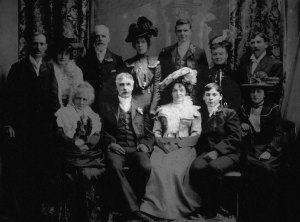I’ve been working closely with Education Officer Cathy Poole on the Heritage Lottery Funded Curzon Memories project – gathering recollections from all generations about the Curzon, ranging from Muriel Williams (discussed in a previous post) who was in the building when it was bombed in 1941 to five-year old school-children from Yeo Moor Junior School, visiting the cinema and learning about all aspects of cinema exhibition, from punching out tickets in the box office to holding a celluloid strip and counting out the 24 frames of one second’s worth of film.
The video interviews are informing my project in two ways: firstly they give a rich sense of the history of the cinema and its importance in the living memory of the local community and secondly there are some real gems of quotations I plan to use in the audio tour. According to George Dimond (who worked as a “button boy” in the 1930s) and his wife Kathleen, cinema entrepreneur Victor Cox who built the cinema was “as tight as the wallpaper on the wall” whereas his step-mother, Blanche Harwood was “the nicest woman you could hope to meet” and used to accompany the silent films on the piano.
This has given me the idea to have two contrasting narrative voices guiding the user through the experience, one male narrator loosely based on Victor Cox – representing the hard-nosed business side of the cinema industry; and the other female narrator loosely based on Blanche Harwood – representing the spirit and magic of cinema. This idea to use the male and female narrators, perhaps often contradicting or at least giving different points of view of the cinema’s history, will enable me to allow different voices and versions of the cinema’s history, acknowledging the inevitably contingent nature of interpreting the archive.
I’m very much influenced by Angela Carter’s radio plays here, published in The Curious Room – particularly her two “artificial biographies” of Victorian fairy-painter Richard Dadd, and Edwardian novelist Ronald Firbank – in both she uses the dual male/female narrators to explore the lives of her subjects, and indeed, her subjects often “talk back” disagreeing with the way in which they have been represented by the narrators. I explore this in my chapter on Carter’s radio biographies in my book Anagrams of Desire: Angela Carter’s Writing for Radio, Film and Television (MUP, 2003). Anyway, I’d like to use a similar technique, as I am not claiming to be creating the definitive history of the cinema, but asking people to reflect on the ongoing resonances of the building within the community.
I’m in the process of writing the script at the moment, but there has been a bit of a hiatus what with Christmas, man flu, MeCCSA and now marking.


Pingback: Curzon Memories App at MovIES | The Curzon Project
Pingback: You stupid boy!: Ian Lavender is the voice of the Curzon’s Victor Cox | The Curzon Project